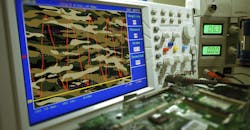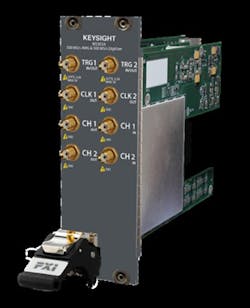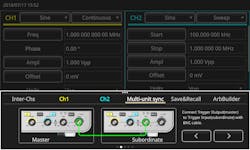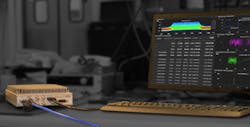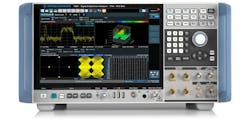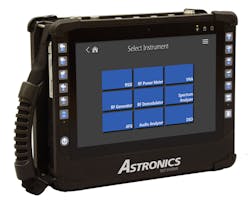Download this article in PDF format.
Greater complexity in military electronic systems requires more capabilities in the measurement equipment used to test those systems. Consequently, various market studies predict healthy growth for at least the next five years for test equipment aimed at specific markets within military electronics, such as mobile radio testing and aviation test equipment. Mobile radios are being designed smaller and lighter with multiple frequency bands and modulation formats, while aviation testing must account for the increased use of robotic and automated systems as well as RF/microwave and digital electronics systems.
In the case of mobile radios, single models are being designed with multiple modulation formats, switchable bandwidths, and increased frequency ranges that must be covered by candidate test instruments. Aviation testing involves a wide range of measurements, from characterizing communications and GPS radios to checking brakes, hydraulic systems, and vacuum integrity. Increasing use of military unmanned aerial vehicles (UAVs) is a main driver behind the expected growth in demand for electronic test equipment aimed at aviation systems. Major customers for test equipment in these two military market areas are expected to be Boeing, General Electric, Honeywell, Lockheed Martin, and Rockwell Collins.
Test equipment for evaluating the RF/microwave performance levels of mil/aero systems and their components covers a wide range of frequencies and functions due to the diversified nature of military electronic systems. An analyzer that can digitize and accurately display the key parameters of a radar pulse may not be the best choice for deciphering the characteristics of a secure radio communications system.
Leading suppliers of test equipment for military electronic applications are quite aware of the needs of military specifiers. They are continually evaluating available high-frequency technologies for what might form the basis for next-generation test equipment. Their efforts result in constantly improving test gear for the two main measurement functions needed to characterize military electronic systems: signal generation and analysis.
Generating Signals
Signal generators for military applications must cover an enormous amount of ground in terms of frequency and waveform type, given the range of signal formats used—from radar pulses to complex modulated millimeter-wave (mmWave) signals in secure communications systems. Rather than rely on a conventional swept-frequency signal generator, military systems testers are turning more to arbitrary waveform generators (AWGs). AWGs have the capability to almost randomly program different waveform formats over a defined frequency range.
Although early AWG models were limited in frequency and functionality, newer models are providing more of the signal-generation capabilities needed for evaluating different military electronic systems. Of course, as commercial applications such as advanced driver-assistance systems (ADAS) increasingly adopt waveforms (radar pulses) like those used by the military, many of the same AWGs employed in military electronic testing will also work in commercial applications.
1. Model M3302A is an AWG that also incorporates a two-channel, 500-Msamples/s digitizer in its compact PXIe format. (Courtesy of Keysight Technologies)
In the case of the M3302A AWG from Keysight Technologies, it can also be used to digitize the signals that must be “imitated” by its AWG section. The PXIe modular instrument (Fig. 1) provides two channels at 500 Msamples/s and 16-b vertical resolution as an AWG, and two channels at 500 Msamples/s and 14-b resolution as a digitizer. Whether for signal generation or capture, it can hold as much as 2 GB of random-access memory (RAM).
The two key instrument functions are designed to work together as an integrated system, with less than 400-ns latency from input-to-output signal processing. This combination of functions within such a compact modular footprint (fitting two slots in a 3U-high PXIe chassis) makes the M3302A a good choice for testing electronic-warfare (EW) systems and radars, and performing channel emulation for even advanced software-defined-radio (SDR) systems. It can be used with software or hardware programming, or no programming, using a mechanical control interface.
The trend of adding functionality to essential instrument functions also follows in the model UHFAWG AWG from Zurich Instruments, which integrates signal generation and detection within the same compact instrument. As with the Keysight AWGs, it can program its own waveforms and digitize external signals via its two 600-MHz input channels. The two channels are tightly matched in terms of amplitude and phase characteristics to provide phase coherency for the most demanding multichannel test applications.
For radio and other system testing, such an AWG would inject test signals into a system’s intermediate-frequency (IF) ports or add a frequency upconverter to reach the RF/microwave frequency range. In contrast to conventional swept-frequency RF/microwave test signal sources, such as those based on frequency-synthesized YIG or voltage-controlled oscillators, AWGs provide the means to define test signals by key signal characteristics.
The recently launched AFG31000 series of AFGs from Tektronix provide signal bandwidth to 250 MHz. The test signal sources resemble small computers, using a 9-in. diagonal capacitive touchscreen for display and straightforward programming (Fig. 2).
2. The AFG31000 series of arbitrary function generators use a large capacitive touchscreen to define waveform parameters. (Courtesy of Tektronix)
For wide bandwidth within a single box, there’s the model N5193A UXG Agile Signal Generator from Keysight Technologies, which comes in two versions: 10 MHz to 20 GHz or 10 MHz to 40 GHz, in standard rack-mount enclosures. The test signal source can provide as much as +10 dBm output power across the frequency range, with optional attenuators bringing output levels as low as −130 dBm. The test signal source can generate everything from CW signals to short pulses, with pulse widths as narrow as 4 ns with 40-ps typical accuracy and 10-ps delay resolution. Frequency switching speeds run from typically 1 µs in standard units to 50 ns as an option.
For even wider bandwidth, the MG3690C analog signal generator from Anritsu provides a frequency range of 0.1 Hz to 70 GHz from a single coaxial connector. With typical frequency switching speed of 5 ms, it generates pulses as narrow as 100 ns. It also comes in a rack-mount enclosure (Fig. 3) meant for laboratory applications.
3. The model MG3690C signal generator provides signals covering 0.1 Hz to 70 GHz from a single coaxial connector. (Courtesy of Anritsu Co.)
Analyzing Spectrum
Spectrum and signal analyzers, important tools in any military electronics test solution, are also commonly found in rack-mount enclosures as well as in portable and modular packages. However, Signal Hound added new meaning to modularity in test equipment with its model SM200A USB spectrum analyzer, with a compact size that belies its 20-MHz-to-20-GHz real-time analysis bandwidth.
The firm recently demonstrated the analyzer at the 55th Annual Association of Old Crows (AOC) International Symposium in partnership with the Linux-based SCEPTRE signal-collection software from 3dB Labs (Fig. 4) for spectrum monitoring, including for intelligence, surveillance, and reconnaissance (ISR) and signal-intelligence (SIGINT) applications.
4. The SM200A USB spectrum analyzer (on left) performs ISR and SIGINT measurements when equipped with SCEPTRE software from 3dB Labs. (Courtesy of Signal Hound)
As spectral occupancy reaches into the mmWave range, spectrum analysis and monitoring must follow, and many suppliers have developed benchtop spectrum analyzers with coverage well above 30 GHz. One of the wider-bandwidth signal analyzers, the R&S FSW85 (Fig. 5), has a dc-coupled frequency range of 2 Hz to 85 GHz and an ac-coupled frequency range of 10 MHz to 85 GHz. It has a variety of built-in filters with resolution bandwidths from 1 Hz to 10 MHz for sorting signals.
5. The R&S FSW85 signal analyzer has a dc-coupled frequency range of 2 Hz to 85 GHz and an ac-coupled frequency range of 10 MHz to 85 GHz. (Courtesy of Rohde & Schwarz)
The FSW85 achieves a displayed average noise level (DANL) of typically −123 dBm or better at 85 GHz with YIG preselection and no attenuation or preamplification, and much better at lower frequencies. RF/microwave input signal ports are equipped with 1.0- and 1.85-mm male coaxial connectors. Numerous software packages are available for the spectrum analyzer, including for pulse and chirp testing.
Portability is an important attribute for many test instruments meant for military electronic testing in the field, and Keysight’s FieldFox handheld analyzer is well-known for its measurement power in a small package. Models are available with “just” spectrum analyzers, with vector network analyzers (VNAs), and with combination spectrum analyzers and power meters operating at frequencies to 50 GHz to meet in-field requirements for higher-frequency signal analysis. All three types of FieldFox analyzers can make pulsed measurements over their frequency ranges, with starting frequencies of 30 kHz, 100 kHz, and 2 MHz.
In terms of integrating measurement power into a small package, few instruments can match the CTS-6010 tactical radio test set from Astronics. It includes an RF/microwave signal generator, audio analyzer, RF/microwave signal analyzer, RF power meter, and oscilloscope in package with upgradable modularity (Fig. 6). Optimized for military radio testing, the signal generator, spectrum analyzer, and power meter all cover a frequency range of 1 MHz to 6 GHz. The two-channel oscilloscope is lower in frequency, with a bandwidth of 25 MHz and voltage range of ±40 V.
6. The CTS-6010 tactical radio test set packs more than a dozen instrument functions covering 1 MHz to 6 GHz into a handheld housing. (Courtesy of Astronics)
These portable analyzers represent only a small sample of the many portable instruments available for in-field radar and radio testing, including the A734 portable analyzer from ProTek and the Spectrum Master line of portable spectrum analyzers from Anritsu, with its model MS2760A-0110 and a frequency range of 9 kHz to 110 GHz and dynamic range of better than 100 dB at 110 GHz.
About the Author
Jack Browne
Technical Contributor
Jack Browne, Technical Contributor, has worked in technical publishing for over 30 years. He managed the content and production of three technical journals while at the American Institute of Physics, including Medical Physics and the Journal of Vacuum Science & Technology. He has been a Publisher and Editor for Penton Media, started the firm’s Wireless Symposium & Exhibition trade show in 1993, and currently serves as Technical Contributor for that company's Microwaves & RF magazine. Browne, who holds a BS in Mathematics from City College of New York and BA degrees in English and Philosophy from Fordham University, is a member of the IEEE.
